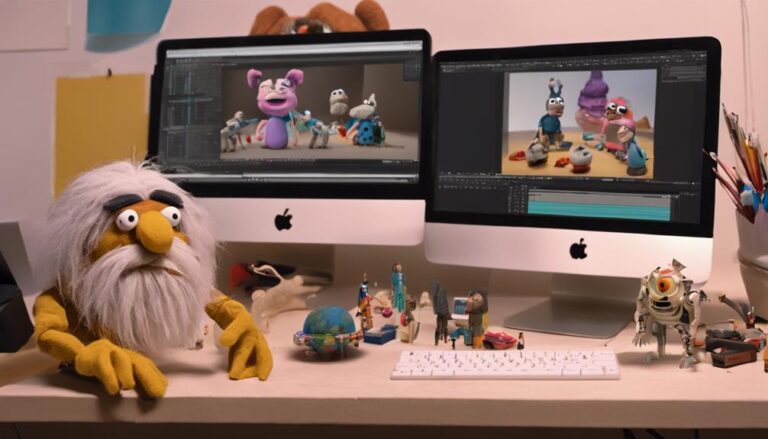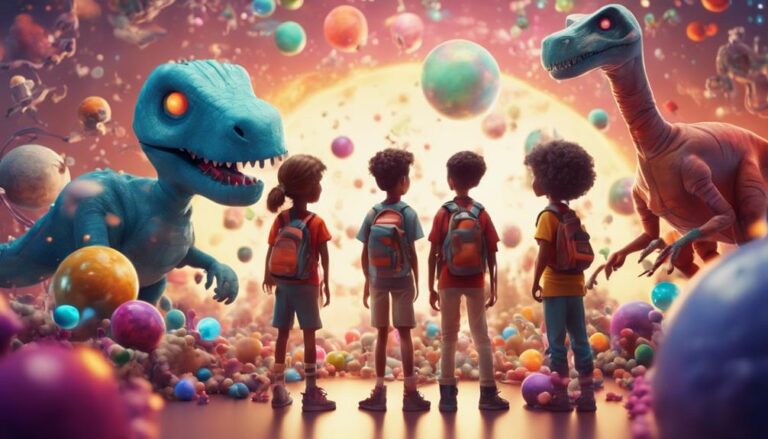Essential Animation Video Storytelling Tips for Beginners
When creating an animation video, start by defining your target audience to understand their needs and motivations. Develop a strong narrative with a clear three-act structure, character arcs, and a well-paced story. Craft engaging characters with unique personalities and relatable motivations. Use visual storytelling techniques like metaphors, symbolic imagery, and lighting to add depth and mood. Finally, craft a compelling script with clear structure, natural dialogue, and concise action lines. By mastering these essentials, you'll be well on your way to creating captivating animation videos – and the next steps in your storytelling journey are just ahead.
Key Takeaways
- Define your target audience, including demographics, interests, and pain points, to create content that resonates with them.
- Develop a strong narrative structure with a clear three-act flow, engaging characters, and well-paced storytelling.
- Craft multi-dimensional characters with unique personalities, motivations, and relatable traits to capture the audience's emotions.
- Utilize visual storytelling techniques, such as metaphors, symbols, and composition, to convey complex ideas and evoke emotions.
- Write a clear, concise script with natural dialogue, snappy action lines, and an authentic tone to bring your story to life.
Define Your Target Audience
Your target audience is the foundation of your animation video storytelling. Before you start crafting your story, you need to know who you're telling it to.
Identifying your target audience will help you create content that resonates with them.
To define your target audience, start by considering their age demographics. Are they young adults, middle-aged, or seniors? Each age group has unique preferences, values, and interests that should be reflected in your storytelling.
Next, create viewer personas that outline their characteristics, behaviors, and pain points. What problems do they face, and how can your animation video help solve them?
Your viewer personas should also include information about their interests, goals, and motivations. What kind of content do they engage with, and what type of messaging resonates with them?
Develop a Strong Narrative
Now that you have a clear understanding of who your target audience is, it's time to craft a narrative that speaks to them.
A strong narrative is the backbone of any successful animation video, and it's essential to get it right.
Your narrative should be engaging, relatable, and well-paced to keep your audience invested in your story.
When developing your narrative, consider the following key elements:
- *Show, don't tell*: Rather than telling your audience what's happening, show them through action, dialogue, and visuals.
- *Create a clear structure*: A clear three-act structure can help guide your narrative and ensure it flows logically.
- *Use character arcs*: Give your characters a clear journey to follow, with a defined beginning, middle, and end.
- *Control story pacing*: Balance action, dialogue, and quiet moments to keep your narrative moving at a steady pace.
Create Engaging Characters
Crafting memorable characters is essential to drawing your audience into the world of your animation video.
Your characters should be multi-dimensional, with unique personalities, strengths, and weaknesses. When creating your characters, consider their motivations – what drives them, what're their goals, and what do they fear? This will help you develop characters that are relatable and authentic.
When designing your characters, think about how they'll interact with each other.
Developing emotional connections between your characters will make your story more engaging and believable. Ask yourself, how do your characters feel about each other? What're their relationships like? Creating these emotional connections will help your audience invest in your characters and care about their journey.
Use Visual Storytelling Techniques
Compelling characters are just the beginning.
To take your animation video storytelling to the next level, it's time to focus on visual storytelling techniques that capture your audience's attention and imagination.
By using visual elements effectively, you can convey complex ideas, evoke emotions, and create a lasting impression.
- Use visual metaphors: Represent abstract ideas or concepts with concrete objects or images that resonate with your target audience. This will help them understand and connect with your message on a deeper level.
- Incorporate symbolic imagery: Add depth and meaning to your story with symbols that carry significance. This could be a specific color, object, or pattern that represents a theme or idea.
- Play with lighting and shadows: Create mood and atmosphere with lighting and shadows that set the tone for your story.
- Experiment with composition: Use the placement of characters, objects, and text to guide the viewer's attention and create visual interest.
Craft a Compelling Script
Craft a Compelling Script
Developing a script that resonates with your audience is crucial to effective animation video storytelling.
A well-crafted script is the backbone of your animation video, providing the foundation for engaging visuals and a compelling narrative.
To create a script that captivates your audience, focus on a clear script structure. This includes a strong opening that hooks your viewers, a concise and logical progression of events, and a satisfying conclusion that leaves a lasting impression.
When writing your script, pay attention to dialogue flow.
Ensure that conversations between characters sound natural and authentic, revealing their personalities and motivations.
Avoid long, drawn-out monologues and instead opt for concise, snappy dialogue that propels the story forward.
Use action lines to set the scene and provide context for your characters' interactions.
Frequently Asked Questions
What Software Is Best for Animation Beginners?
You're looking for animation software, and there are many options. Consider Adobe Animate, Blender, or OpenToonz, which offer various animation styles and in-depth software tutorials to help you get started and grow as an animator.
Can I Use Royalty-Free Music in Animations?
You can use royalty-free music in your animations, but check the music licensing terms first. Ensure the audio quality is high and suitable for your project to avoid any copyright issues or sound degradation.
How Long Should an Animation Video Be?
When deciding on content length, consider your viewers' attention span. You want to keep them engaged. Aim for 2-5 minutes, depending on your content's complexity and your audience's interests, to hold their attention effectively.
What Is the Ideal Frame Rate for Animation?
You're optimizing frame rates for a seamless experience. Aim for 24-60 frames per second (FPS) for smooth motion rendering. Higher FPS isn't always better, as it may increase file size and slow down playback. Experiment to find your sweet spot.
Do I Need to Copyright My Animation Work?
When creating original content, you're wise to protect your intellectual property. You should copyright your work to secure legal protections, ensuring you own the rights and can control its use, reproduction, or distribution.
Conclusion
You've made it through the essential animation video storytelling tips for beginners. Now, put these techniques into practice and bring your story to life. Remember, it's all about connecting with your audience, crafting a compelling narrative, and using visuals to elevate your message. Keep learning, experimenting, and pushing the boundaries of what's possible. With dedication and creativity, you'll be well on your way to creating engaging animation videos that captivate and inspire your viewers.






